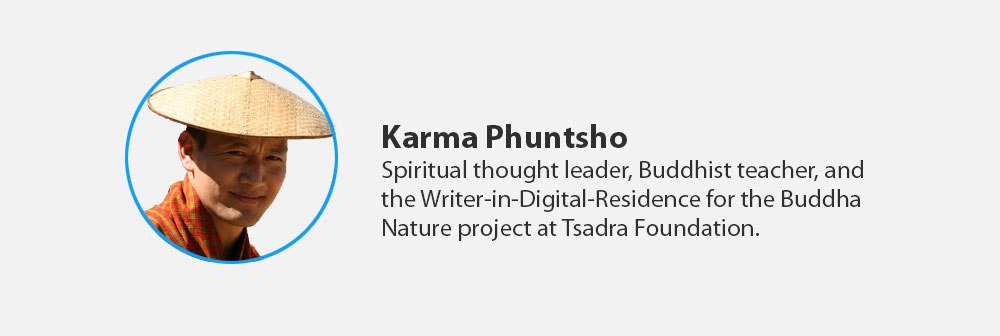Konchosum (དཀོན་མཆོག་གསུམ་) or the Three Jewels is perhaps the most basic and well known list in Buddhism. Almost every Bhutanese know about it even as a child and continue to believe in and pray to the Three Jewels throughout their life. However, beyond listing the Three Jewels or three objects of refuge – the Buddha, dharma or his teachings and sangha or his followers – very few ask what actually constitutes the Three Jewels and even fewer fully understand what the Buddha, dharma and sangha refer to.
In the basic theories of Buddhism, which spread widely even during the lifetime of the historical Buddha Śākyamuni, the Buddha referred to a rare person who has reached full enlightenment after having uprooted all negative emotions and impulses, and realized the true nature of things. The dharma referred to the teachings of the Buddha, which existed in the two forms of doctrines and the practical experiences. The sangha are the followers of the Buddha who upheld the dharma including both the monastic and lay practitioners. One took refuge in the Buddha by accepting the Buddha as a teacher, in the dharma by accepting it as one’s way of life, and in the sangha as companions on the path.
We find a more scholastic presentation of the Three Jewels by the famous Indian scholar Vasubandhu according to the Vaibhaṣika School of thought in his magnum opus Abhidharmakośa. According to this system, the Buddha as an individual is a prince who was born as a result of his previous karma. So, his person as such is not transcendental per se but an assembly of ordinary psychophysical aggregates. One should not take refuge in the person of the Buddha but rather in the two inner qualities of elimination (སྤངས་པ་) or the absence of defilements, and spiritual realization (རྟོགས་པ་). The realization or spiritual knowledge of the Buddha, which is transcendent, is the true Buddha in whom one must take refuge. Similarly, true dharma is not the fleeting words of teachings but the state of nirvāṇa or the absence of defiling elements which the Buddha and his followers have attained. The real sangha to take refuge in is the spiritual realization in the minds of the followers of the Buddha including those who are stream-enterers, once returners, non-returners and arhats.
Maitreya in his Mahāyanottaratantra presents the definition of the Three Jewels according to a particular Mahāyāna understanding. The Buddha, according to him, must possess two sets of three qualities. Buddhahood, with respect to its own benefit, is unconditioned, spontaneous and unknowable, and with respect to benefiting others must have wisdom, compassion and power. The dharma includes the freedom from defiling emotions and the path to such freedom. The state of freedom from negative emotions is described as inconceivable, non-dualistic and non-conceptual. The path to freedom is described as pure, luminous and remedial or antidotal in nature. These two correspond to the third and fourth of the Four Noble Truths. Sangha, in this context, refers to the wise Bodhisattvas who have reached the irrevocable stage of the Mahāyāna path. They are said to possess the understanding of single nature of reality, of the phenomenal diversity of things, and the pure internal insight. The Mahāyāna sangha mainly consists of Bodhisattvas who are already on the paths and stages to become a buddha.
The definition of the Buddha, dharma and sangha further varies as one approaches the different schools of Vajrayāna system. Instead of seeking refuge in an external set of Three Jewels, Vajrayāna traditions often points to the latent qualities within a person and identifies the potential Buddha, dharma and sangha and encourages the practitioner to take refuge in oneself and the enlightened qualities within. The Vajrayāna traditions add further the Three Roots (རྩ་གསུམ་) as an object of refuge. They add the triad of sacred channels, energies and fluids, and also the triad of nature, essence, immanence as objects of refuge. Thus, the range of buddhas, dharmas and sanghas increase extensively in the Mahāyāna and Vajrayāna with the inclusion of many cosmic, celestial and non-human buddhas, many large sūtras and esoteric tantras as dharma, and numerous spiritual beings as part of sangha.
Whichever tradition one follows, it is crucial to understand the objects of refuge in order to effectively undertake the most fundamental Buddhist practice of taking refuge in the Three Jewels. Without knowing why and in what one is taking refuge, the basic Buddhist practice risks becoming a hollow ritual or a practice of blind faith.
The three objects of refuge, Maitreya states in his Ultimate Continuum, are considered as jewels (ratna in Sanskrit and konchok དཀོན་མཆོག་ in Chokey) for six reasons. Their is difficult to encounter, they are stainless, they possess power, they are the ornaments of the world, they are supreme, and they are changeless.


